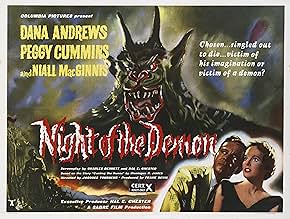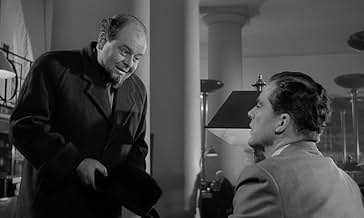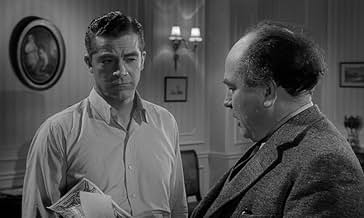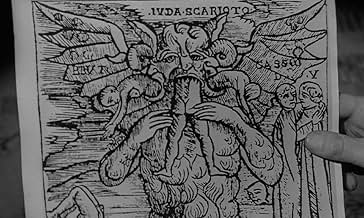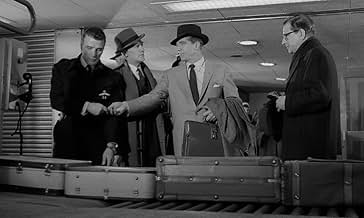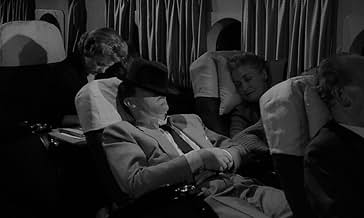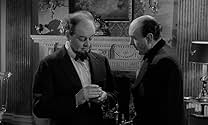IMDb-BEWERTUNG
7,4/10
16.395
IHRE BEWERTUNG
Professor John Holden kommt zu einer Parapsychologie-Konferenz nach London, nur um sich dann in einer Ermittlung gegen den Teufelsanbeter Julian Karswell wiederzufinden.Professor John Holden kommt zu einer Parapsychologie-Konferenz nach London, nur um sich dann in einer Ermittlung gegen den Teufelsanbeter Julian Karswell wiederzufinden.Professor John Holden kommt zu einer Parapsychologie-Konferenz nach London, nur um sich dann in einer Ermittlung gegen den Teufelsanbeter Julian Karswell wiederzufinden.
- Auszeichnungen
- 1 Gewinn & 1 Nominierung insgesamt
Charles Lloyd Pack
- Chemist
- (as Charles Lloyd-Pack)
Ausgewählte Rezension
Filmed in England, this 1958 film was originally released with a running time of 95 minutes under the title NIGHT OF THE DEMON; when it reached the United States it had a running time of 83 minutes and the title CURSE OF THE DEMON. Both versions are contained on this DVD, with the English version the better for those twelve minutes, but in truth there is little significant difference between the two, and if you are a connoisseur of 1950s horror films you will find both equally fascinating.
Based on the short story "Casting the Runes" by M.R. James, DEMON offers the tale of American psychologist John Holden (Dana Andrews) who travels to a conference in England, planning to debunk a devil worshiping cult led by Karswell (Niall MacGinnis.) Unfortunately for the professionally skeptical Holden, Karswell's powers are genuine: he has successfully translated an ancient text and, through runes written on parchment, casts a curse first against Holden's colleague and then against Holden himself.
DEMON was directed by Jacques Tourneur, who worked with producer Val Lewton to create a series of memorable and distinctly noir-ish horror films at RKO in the 1940s: CAT PEOPLE, I WALKED WITH A ZOMBIE, and THE LEOPARD MAN. All three films created a sense of unease and scream-aloud fear by implication and suggestion, and although DEMON is much more explicit in its effects, Tourneur brings the same sensibility to bear on DEMON, endowing it with remarkable authority and power in spite of several distinct flaws.
Chief among these flaws is the script, which can best be described as somewhat abrupt in terms of dialog, and leading man Dana Andrews, whose performance is remarkably unsubtle even in a decade noted for a lack of cinematic restraint. Film lore also has it that Tourneur lobbied against showing the demon on screen, and given the fact that the visual is hardly inspired this clearly would have been the better choice. None the less, DEMON has jolts and jars aplenty, not the least of which is Karswell: Niall MacGinnis' performance, with its mixture of the commonplace and the flatly evil, is remarkably fine. The film also sports a host of memorable set pieces: the storm, the flying parchment, Dr. Holden's exploration of Karswell's mansion, Dr. Holden's run through the night forest, and the final train sequence, to name but a few.
Although it is not well known today, like Tourneur's films with Lewton, DEMON has cast a very long shadow in terms of influence, and it is very difficult to imagine such films as ROSEMARY'S BABY and THE CHANGELING without both this film and those that proceeded it. Recommended.
GFT, Amazon Reviewer
Based on the short story "Casting the Runes" by M.R. James, DEMON offers the tale of American psychologist John Holden (Dana Andrews) who travels to a conference in England, planning to debunk a devil worshiping cult led by Karswell (Niall MacGinnis.) Unfortunately for the professionally skeptical Holden, Karswell's powers are genuine: he has successfully translated an ancient text and, through runes written on parchment, casts a curse first against Holden's colleague and then against Holden himself.
DEMON was directed by Jacques Tourneur, who worked with producer Val Lewton to create a series of memorable and distinctly noir-ish horror films at RKO in the 1940s: CAT PEOPLE, I WALKED WITH A ZOMBIE, and THE LEOPARD MAN. All three films created a sense of unease and scream-aloud fear by implication and suggestion, and although DEMON is much more explicit in its effects, Tourneur brings the same sensibility to bear on DEMON, endowing it with remarkable authority and power in spite of several distinct flaws.
Chief among these flaws is the script, which can best be described as somewhat abrupt in terms of dialog, and leading man Dana Andrews, whose performance is remarkably unsubtle even in a decade noted for a lack of cinematic restraint. Film lore also has it that Tourneur lobbied against showing the demon on screen, and given the fact that the visual is hardly inspired this clearly would have been the better choice. None the less, DEMON has jolts and jars aplenty, not the least of which is Karswell: Niall MacGinnis' performance, with its mixture of the commonplace and the flatly evil, is remarkably fine. The film also sports a host of memorable set pieces: the storm, the flying parchment, Dr. Holden's exploration of Karswell's mansion, Dr. Holden's run through the night forest, and the final train sequence, to name but a few.
Although it is not well known today, like Tourneur's films with Lewton, DEMON has cast a very long shadow in terms of influence, and it is very difficult to imagine such films as ROSEMARY'S BABY and THE CHANGELING without both this film and those that proceeded it. Recommended.
GFT, Amazon Reviewer
Handlung
WUSSTEST DU SCHON:
- WissenswertesJacques Tourneur never planned to show the monster but to leave it instead to the audience's imagination. However, the studio insisted that the monster be shown and added it in post-production, allegedly without Tourneur's consent, approval, or involvement. "The scenes where we really see the demon were shot without me. All except one: I shot the sequence in the woods where Andrews is pursued by this sort of cloud." [Tourneur himself in Midi-Minuit Fantastique 5.65]. He also said, "It should have been unveiled bit by bit without it ever really being shown." [in Cinefantsatique; '73]
- PatzerAt the beginning, when Professor Harrington is driving to Dr. Karswell's residence, the steering wheel is on the left, and the POV is from the passenger seat, looking at the right side of his face. On his way back to his home, it's a mirror image of the original (flipped shot).
Actually, the car is narrow, and it is an optical illusion that the steering wheel on the left. It is a right-hand drive vehicle as can be seen when he looks out the window at the Lufford Hall sign at the gate, as well as when he exits the car at the house.
- Zitate
Professor Henry Harrington: It's in the trees! It's coming!
- Alternative VersionenThis film exists in three English language versions: (1) The original British release under the title "Night of the Demon", (2) Columbia's edited version for release in the U.S. under the title "Curse of the Demon", and (3) over 20 years later, Columbia replaced their edited U.S. version with the original British version but with the title also changed to "Curse of the Demon". Columbia's DVD release contains both the edited and restored U.S. versions. Although the cover remains the same, Columbia's more recent copies of the their DVD release removes the U.S. version with the restored footage with a print of the original British release with the title "Night of the Demon".
- VerbindungenFeatured in Aweful Movies with Deadly Earnest: Curse of the Demon (1970)
Top-Auswahl
Melde dich zum Bewerten an und greife auf die Watchlist für personalisierte Empfehlungen zu.
- How long is Curse of the Demon?Powered by Alexa
Details
- Erscheinungsdatum
- Herkunftsland
- Sprache
- Auch bekannt als
- Night of the Demon
- Drehorte
- Brocket Hall, Lemsford, Welwyn Garden City, Hertfordshire, England, Vereinigtes Königreich(as "Lufford Hall, Warwickshire")
- Produktionsfirma
- Weitere beteiligte Unternehmen bei IMDbPro anzeigen
- Laufzeit1 Stunde 36 Minuten
- Farbe
- Seitenverhältnis
- 1.66 : 1(original aspect ratio & theatrical release)
Zu dieser Seite beitragen
Bearbeitung vorschlagen oder fehlenden Inhalt hinzufügen

Oberste Lücke
By what name was Der Fluch des Dämonen (1957) officially released in India in English?
Antwort















